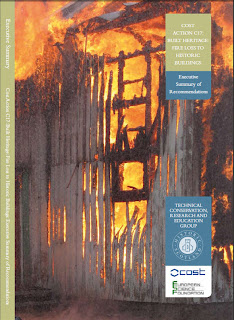COST Action C17 Built Heritage: Fire Loss to Historic Buildings

“COST Action C17 Built Heritage: Fire Loss to Historic Buildings”, which was formally inaugurated in Brussels in December 2002.
The agreed MoU identified four work-packages:
• Working Group 1: Data, loss statistics and evaluating risks.
• Working Group 2: Available and developing technology.
• Working Group 3: Cultural and financial value.
• Working Group 4: Property management strategies.
COST C17 had as its central objective the definition, at a European level, of the degree of loss to built heritage through the effects of fire, and the promotion of remedial actions and recommendations to combat these using minimal invasive techniques. The Action also aimed to address a general lack of statistical information, and a common lack of understanding and appreciation of what measures are available and required. It sought to provide good practice guidance on how to sensitively retrofit modern day fire protection equipment into historic fabric, and to develop related management expertise in dealing with this problem in historic premises.
The operational framework of the Action was developed to consider the special nature of the value of historic buildings, the economic aspects of cultural historic value, and the need for measures to minimise damage if a fire occurs.
Specifically this required consideration of the:
• vulnerability of historic buildings to fire
• risk assessment methodologies
• protection of fabric and content
• prevention of fire and fire spread
• detection and suppression requirements
• training and management of staff
• insurance considerations
In pursuing these intentions, there was a need to integrate and coordinate the associated factors so that a common understanding of the issues might emerge. To achieve meaningful results during the intended life-span of the programme, a strategic approach was adopted.
This focused on:
• compiling statistical data on the extent of heritage at risk.
• promoting statistical research into the consequences and causes of fires – both major fires and more minor incidents (such as small fires to which the fire brigade are not called or false alarms) and their impact. Using risk assessment data gathered as a basis for discussion, a dialogue began to be established with insurance bodies to seek the development of insurance products more closely tailored to historic buildings.
• establishing a well-documented survey of up-to-date technical expertise to assist in influencing future developments in fire protection technology for use in historic buildings.
• defining an appropriate range of passive and active technical equipment countermeasures.
• considering alternative approaches to assist in stemming current loss levels.
• organising a series of conferences and/or workshops to develop thinking for effective risk assessment techniques and risk mapping using insurance company and other data.
• promoting findings and benefits of relevant risk assessment methodologies and property management support.
• effecting know-how dissemination through publishing proceedings and recommendations.
Membership signatory countries involved participants from Austria, Belgium, Bulgaria,Denmark, Finland, France,Hungary, Israel, Italy, Macedonia, Netherlands, Norway, Poland, Serbia and Montenegro, Slovenia, Spain, Sweden,Switzerland, Turkey and the United Kingdom. In addition, corresponding membership interests were established with other organisations and networks, including:
Baltic Countries: Association of Castles and Museums around the Baltic Sea Federation of Finnish Insurance Companies
Canada: Parks Canada
Europe: Comité technique international de prévention et d’extinction du feu (CTIF)
Russia: Russian Civil Defence and Disaster Management Research Institute
International Informatization Academy
WORLD Academy of Sciences for Complex Security
Academy of State Fire Service of Emercom of Russia
United States of America: NFPA Cultural Resources Committee
United Kingdom: Scottish Historic Buildings Fire Liaison Group
Scottish Building Standards Agency
Historic Buildings Fire Research Coordinating Committee
More information in http://www.heritagefire.net/
COST Action C17 Executive Summary of Recommendations could be downloaded from http://fred.english-heritage.org.uk

Comments